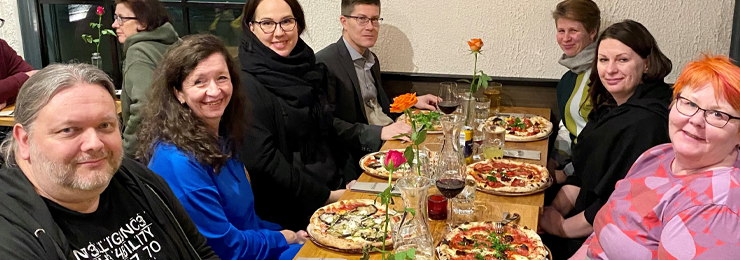Recently, Häme University of Applied Sciences (HAMK) had the opportunity to host three STEM higher education experts from University of Tartu, Estonia. The academic developer of the Faculty of Science and two STEM teachers visited the HAMK Edu research unit and HAMK Design Factory with the goal of strengthening our cross-national collaboration in developing STEM higher education. The special focus of the visit was to discuss new and innovative ways to support STEM teachers to engage their students in meaningful learning.
Despite the growing scientific evidence that active, student-centred teaching methods have more potential in supporting students’ learning, teaching in STEM fields at Finnish and Estonian universities remains largely traditional. To transform STEM higher education up to date, STEM teachers need to be engaged in developing their teaching practices. However, STEM teachers are typically experts in their own subject area but not in educational science, making it difficult for them to apply results of educational research into practice.
During the visit, we agreed that to address this challenge, disciplinary knowledge and practices need to be integrated with an understanding of educational research on teaching and learning within higher education. We discussed the various possibilities to support the teaching development within STEM departments from institution-level pedagogical development and university-industry collaboration. We presented HAMK’s pedagogical development programme and discussed the ways universities can provide structural support for teachers in their development efforts. We also had a visit around HAMK Design Factory facilities and discussed the learning opportunities provided by the Design Factory implementations integrating interdisciplinary student teams, university-industry collaboration, and authentic open-ended challenges.
In addition to the visit to HAMK, we also had the opportunity to visit our colleagues from the national Network for University Mathematics Educators (NUME) network at Tampere University. We observed their implementation of flipped prime time learning in university mathematics education. Since 2019, the engineering students at Tampere University have had the opportunity to study their first-year mathematics courses using this innovative approach, which involves studying through written study materials and short videos, as well as completing a variety of tasks individually and in groups, self- and peer evaluation, tutorials, and prime-time sessions. The goal of this approach is to maximize student engagement and retention by supporting them in regulating their learning and making the most out of their time in class. It is always eye-opening to see the results of long-term development efforts in practice, with the students clearly engaged and working hard in a calm and relaxed atmosphere during the prime-time sessions.
Overall, it was reassuring to see first-hand how the teaching development we know from theory can work in practice. The Tartu experts were excited about the possibility of collaborating with the Finnish NUME network. As the STEM higher education development efforts in Estonia are relatively new, the visitors were also empowered by the future prospects of creating similar educational change efforts and collegial support in Estonia. Also, we learned a lot about the Estonian higher education context and the challenges Estonian STEM teachers face while developing their teaching practices.
We are grateful for the opportunity to collaborate and learn from our colleagues, and we look forward to continuing this journey together. One of the follow-ups of the visit is to jointly organise a seminar at the University of Tartu for STEM higher education teachers. Meanwhile, we stay committed to research-based development of STEM higher education to promote teaching practices that can better support our students’ learning.
Authors
Juulia Lahdenperä, post-doctoral researcher at HAMK Edu research unit, coordinator of the national Network for University Mathematics Educators (NUME)
ChatGPT, OpenAI
This blogpost was written with the assistance of the OpenAI chatbot ChatGPT. The role of ChatGPT was to generate a blogpost based on the list of information the human author gave to them. The generated text was then edited for content clarity and to meet the human author’s own standards for a blogpost.




